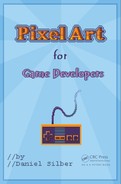CHAPTER 3
Who Am I and Why Do I
Know So Much about
Pixel Art?
W
IWamIandwhatwasIdoingagain?Cometothink
of it, how the hell did I get here? Where did I leave my keys? Brace
yourself for the backstory. Maybe you want to get some chamomile tea or
something to help settle you in for this heartwarming tale.
Many years ago I was an art student with the intention of becoming a
painter. I studied all about how to use traditional renaissance techniques
to create niy artwork and avoided anything about how to apply what was
learned practically (i.e., how to get a job). So focused were my passions that
I convinced my academic adviser that it was in my best interest to postpone
all of myprerequisite classes and take only art and music courses (for a while
I was considering a music major before realizing that I had paralyzing stage
fright). Among my courses was a D graphics course at the Art Academy of
Cincinnati that indirectly altered my professional course for ever aer.
Aer school I found that my myopic focus on art had le me at a slight
(readmajor)disadvantagewhenenteringthejobmarket.Theonlyskillthat
I could isolate as directly marketable was my new familiarity with D mod-
eling. So I took classes and bought a computer to build work to improve my
D portfolio.
At some juncture, due to my D work, I landed an interview at a game
company in Virginia. Before that moment I had never realized that game
13
14 Pixel Art for Game Developers
development could be a profession and was enamored by the marriage of
technology and creativity. Although I did not get the job, I had decided that
this was going to be my profession. This seemed like something I could
studymywholelifewithouteverrunningoutofnewinformationorhaving
it get stale. Although at that point I didn’t really have enough experience to
beveryvaluableinthegameindustry,soIresolvedtogobacktoschool.
Several years later I loaded my wife, dog, two cats, and -month-old
daughter into a plane heading toward Vancouver, BC to study art and ani-
mation for game development at the Art Institute of Vancouver. It was an
amazing adventure where I learned a lot more tricks and tools for creat-
ing D art and animation. At that point in time there really weren’t many
schoolsthattaughtgamedevelopment.Therewereafewoptions,buteach
ofthemhadsomeaspectthatwasnotidealformysituation.Thatparticular
Art Institute had a practicum where you actually build a video game as part
ofthecurriculum—andthatreallysolditforme.Iwasolderthanmostof
my classmates and a couple of them called me “Old Man Silber,” but it was
an incredible experience that transformed me professionally.
I believe that now a lot of the game development classes have cross pol-
linated across the Art Institute schools (as well as other schools) and there
are more options for studying game art and animation, so if you ever chose
that path you may not need to move across the country. So I studied a great
many aspects of game development, concentrating on D art because that
seemed to be the ticket to getting hired in the game industry.
Then aer school I landed my rst job in game development at Hand-
held Games, where I worked as a Pixel Artist and did no D work at all.
I loved it and fell in love with this idiosyncratic media. Over the next two
years I worked on more than a half dozen commercial video games. While
workingatHandheldGamesI’dbeencreditedonNintendoDS,Nintendo
GBA, Vmigo, and “plug and play” games with licenses that include Marvel,
Disney, Pixar, and Nicktoons.
DuringthattimeperiodIcreatedPixelArtanimationsandenvironments
for (+) hours a day, (+) days a week and learned the idiosyncrasies of the
medium while on the job. A few things were shared by my coworkers, but
mostly I learned the hard way—with lots of trial and error.
Since then, I’ve foundedthe game company Interstellar Tortoise LLC and
written some small “indie” games like Pixel Guy’s Quest. I love the Pixel Art
aestheticandwanttodowhatIcantoassistthedevelopercommunityin
gettingthemostoutofthismagnicentstyleofgraphics.
Who Am I and Why Do I Know So Much about Pixel Art? 15
DISCLAIMER(S)
Aswith any creative discipline, there is a large subjective component. There
are some techniques and explanations in which I expect some dissent—and
that is perfectly ne. I’ve tried my best to give guidance and examples that
will be useful, and don’t feel that these are the only strong solutions. Take
the principles that work for you and feel free to dump the rest.
I’ve also made some minor mistakes on some of the artwork in the pages
of this book. At times I had to intentionally sacrice some aspect of quality
inordertospendthetimetomakecleartherelevantexample.Theprocess
of writing this book was a huge eort and sometimes I didn’t have the time
to use best practices while creating examples. Work with me and look for
the point I’m trying to make.
..................Content has been hidden....................
You can't read the all page of ebook, please click here login for view all page.
